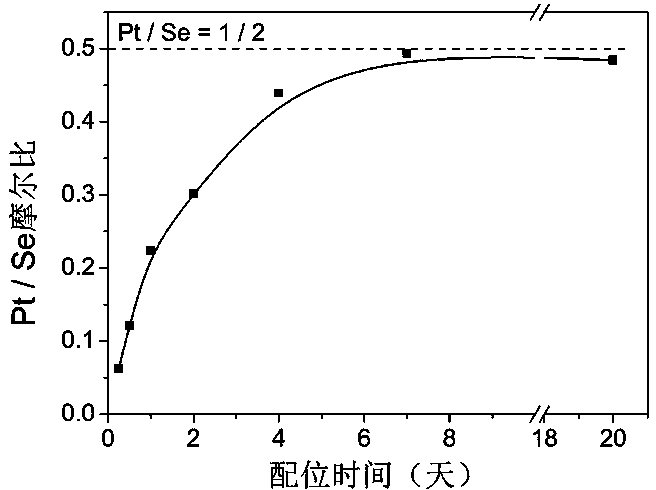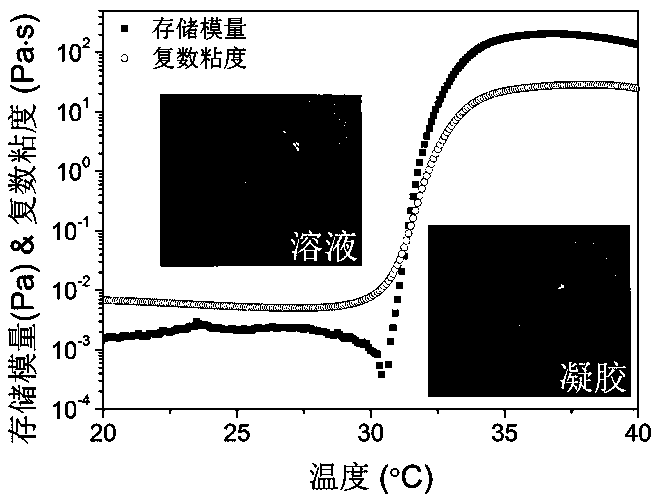A kind of thermogenic hydrogel containing selenium or tellurium and its preparation method and application
A hydrogel and heat-induced technology, which is applied to medical preparations containing active ingredients, medical preparations with non-active ingredients, and pharmaceutical formulas, etc., can solve the problems of decreased drug efficacy, short half-life of drugs, and loss of anticancer activity , to achieve the effect of good fluidity
- Summary
- Abstract
- Description
- Claims
- Application Information
AI Technical Summary
Problems solved by technology
Method used
Image
Examples
Embodiment 1
[0051] Add 27.5 g mPEG (550) into a 250 mL three-necked flask, heat the oil bath to 130 ° C, and vacuumize for 3 h while stirring to remove the moisture in mPEG, then add 50.0 g D,L-lactide (LA) and 50 mg For stannous octoate (containing a small amount of toluene), the temperature of the oil bath was raised to 150°C, and the reaction was continued for 12 h under an argon atmosphere. After the reaction is completed, vacuumize for 3 h to remove unreacted monomers and low-boiling products, dissolve the reaction product in dichloromethane solution, and then precipitate with ether to obtain mPEG-PLA diblock copolymer (Copolymer-1). The yield is about 70%, and it is stored at -20°C. The number-average and weight-average molecular weight ( M n , M w ) are 1980 and 2530, respectively, and the molecular weight distribution coefficient ( M w / M n ) is 1.28.
Embodiment 2
[0053] Add 27.5 g mPEG (550) into a 250 mL three-necked flask, heat the oil bath to 130 ° C, and vacuumize for 3 h while stirring to remove the moisture in mPEG, then add 55.6 g D,L-lactide (LA), 14.9 g ethyl alcohol Lactide (GA) and 90 mg stannous octoate (containing a small amount of toluene), the temperature of the oil bath was raised to 150 °C, and the reaction was continued for 12 h under an argon atmosphere. After the reaction was completed, vacuumize for 3 h to remove unreacted monomers and low-boiling products. The reaction product was dissolved in dichloromethane and precipitated with ether to obtain mPEG-PLGA diblock copolymer (Copolymer-3), with a yield of about 87 %, stored at -20°C. The number-average and weight-average molecular weight ( M n , M w ) were 2410 and 3570, respectively, and the molecular weight distribution coefficient ( M w / M n ) is 1.48.
Embodiment 3
[0055] Add 30.0 g PEG (1500) into a 250 mL three-neck flask, heat the oil bath to 130 ° C, and vacuumize for 3 hours while stirring to remove the moisture in the PEG, then add 54.6 g D,L-lactide (LA), 14.2 g Glycolide (GA) and 75 mg stannous octoate (containing a small amount of toluene), the oil bath was heated to 150 ° C, and the reaction was continued for 12 h under an argon atmosphere. After the reaction is completed, vacuumize for 3 h to remove unreacted monomers and low-boiling products, pour out the reaction product while it is hot, wash it in 80°C water for several times, and freeze-dry it to obtain a PLGA-PEG-PLGA triblock copolymer ( Copolymer-6), the yield was about 87%, and it was stored at -20°C. The number-average and weight-average molecular weight ( M n , M w ) were 5490 and 6940, respectively, and the molecular weight distribution coefficient ( M w / M n ) is 1.26. LA / GA=3 / 1.
PUM
| Property | Measurement | Unit |
|---|---|---|
| transition temperature | aaaaa | aaaaa |
Abstract
Description
Claims
Application Information
 Login to View More
Login to View More - R&D
- Intellectual Property
- Life Sciences
- Materials
- Tech Scout
- Unparalleled Data Quality
- Higher Quality Content
- 60% Fewer Hallucinations
Browse by: Latest US Patents, China's latest patents, Technical Efficacy Thesaurus, Application Domain, Technology Topic, Popular Technical Reports.
© 2025 PatSnap. All rights reserved.Legal|Privacy policy|Modern Slavery Act Transparency Statement|Sitemap|About US| Contact US: help@patsnap.com



